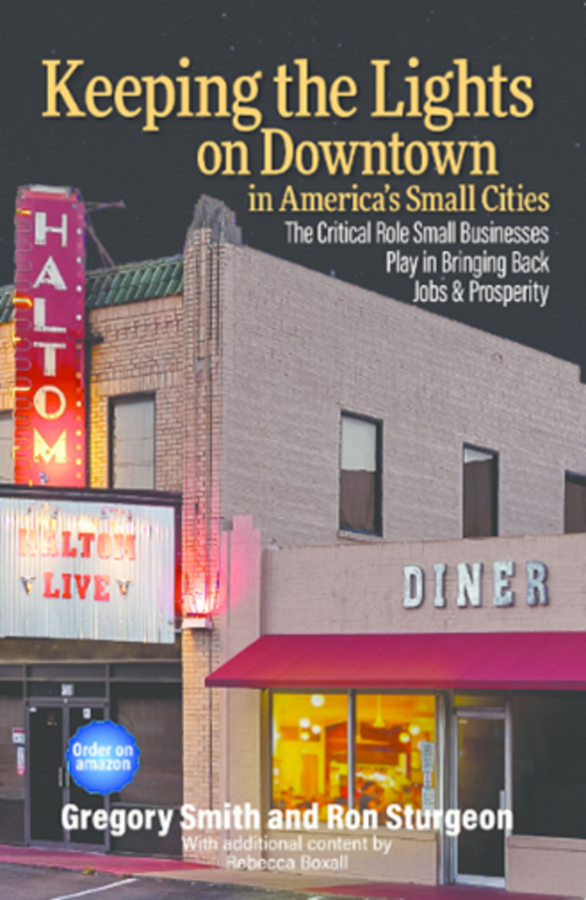Keeping the Lights on Downtown in America’s Small Cities offers modern strategies for reversing decline in inner-city areas across the country
HALTOM CITY, TX, February 10, 2023 /24-7PressRelease/ — Many cities in America are struggling with outdated zoning which negatively impacts growth and development of housing, retail, commercial space, and industrial-use property. In their new book, Keeping the Lights on Downtown in America’s Small Cities, authors Smith and Sturgeon highlight a White Paper written by architect Rebecca Boxall that proposes incremental up-zoning to revitalize cities.
According to Ms. Boxall, “One of the biggest obstacles to redevelopment is the time, cost, and hassle of getting a zoning change or change-of-use permit… cities would benefit from less-rigid land planning and allow for creative, innovative development, with less red tape.” She therefore proposes that cities “Allow incremental up-zoning and/or use combinations by right – meaning that the property owner or developer would not have as much red tape to navigate – in specific areas of cities in need of revitalization.”
In her White Paper, Ms. Boxall says that up-zoned areas should be considered “living labs” and she offers real-world ideas to consider. To start, a city could choose an area known to be in decline such as a particular segment of a road or a broader category as may be appropriate and allow an incremental jump in zoning category, or combination of existing plus new, by right. One idea would be to identify a specific residential area along an arterial or collector road and authorize incremental up-zoning to the next category (e.g., the lowest multi-family zone) or to a mixed-use that might be suitable for the area. Another would be to allow pop-up cafés on light use industrial sites (such as car lots or auto repair shops) which would not only encourage small business development but would add street appeal and provide industrial customers somewhere nearby to wait. Cities should also consider the possibility of reducing setbacks and lot coverage minimums in certain areas, increasing height allowances, and/or reducing parking requirements if such changes would be beneficial.
Ms. Boxall also recommends that city leaders create a Pattern Book. The book would serve as a guideline for developers and designers by outlining what the city wants to see physically in terms of form and appearance (rather than concentrating solely on “uses”). Ideally, the Pattern Book would be descriptive rather than prescriptive and would allow for some degree of creativity and flexibility. Ms. Boxall’s recommendation to city leaders is to “Concentrate on what you want, not what you don’t want for your city. This involves really thinking about what you are trying to achieve and developing a rationale for it.”
Ms. Boxall strongly believes that “There are unlimited ideas that could come into being if not for onerous zoning ordinances.” To read more, check out Keeping the Lights on Downtown in America’s Small Cities by Gregory Smith and Ron Sturgeon. The book is available at Amazon.com. Boxall is a current Arlington TX councilwoman and is also the Principal Architect at Affinity Southwest.
Haltom United Business Alliance Founder Ron Sturgeon has launched a campaign to revitalize South and Central Haltom City. To draw attention to the initiative, Sturgeon has purchased billboards with the URL Make Haltom City Thrive Again.com. On the site and companion Facebook page, Sturgeon shares a concept plan with specific reforms to attract the hundreds of millions of dollars in private investment needed to make Haltom City’s beleaguered corridors bustle again.
About Haltom City
Haltom City is a diverse, majority working-class city located between Dallas and Fort Worth in Tarrant County, TX. Haltom City is minutes from both the DFW Airport and Downtown Fort Worth with direct access to major highways including I-820 and SH-121. Due to an outdated and restrictive use matrix that discourages new business and deters growth, several areas of Haltom City have seen a decline in small businesses which provided goods and services and were a significant source of jobs, including the once-thriving automotive industry. However, Haltom City has the opportunity to reverse this trend and should prioritize development of inner-city land and vacant buildings, particularly in the major corridors close to the city’s center. The city is financially healthy with a capable manager and staff who would like to see diverse business development occur and need the support of the City Council to make it happen.
About Make Haltom City Thrive Again
The Make Haltom City Thrive Again website offers information and resources about its purpose and goals. For more on Sturgeon’s personal ideas and background, check out his book Keeping the Lights on Downtown in America’s Small Cities and watch the videos on his Facebook page. Ron is also the founder of the Haltom United Business Alliance (HUBA) which represents existing business interests in Haltom City and promotes growth of diverse businesses as well. HUBA is not a political action committee and does not endorse candidates. If/when Ron endorses candidates, he will do so on his own with the Make Haltom City Thrive Again initiative.
About Haltom United Business Alliance
Haltom United Business Alliance (HUBA) is a group of business owners dedicated to representing existing business interests in Haltom City and promoting the growth of diverse businesses as well. Innovative strategies are needed to create a strong tax base and enhance quality of life for residents, city employees, and business owners. All Haltom City business owners are eligible to join HUBA. For more information, contact Joe Palmer at (682) 310-0591 or by email at [email protected] or visit the group’s Facebook page at Haltom United Business Alliance.
—
For the original version of this press release, please visit 24-7PressRelease.com here





